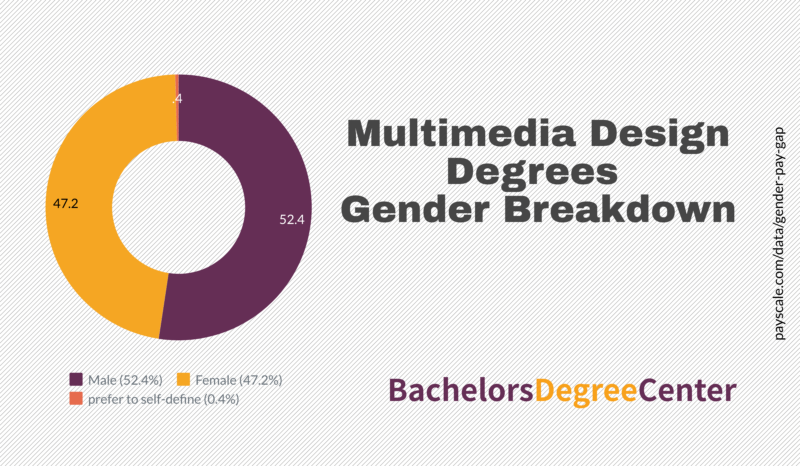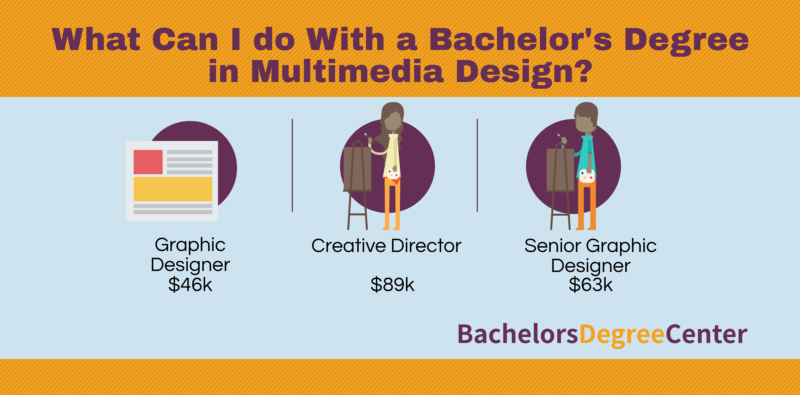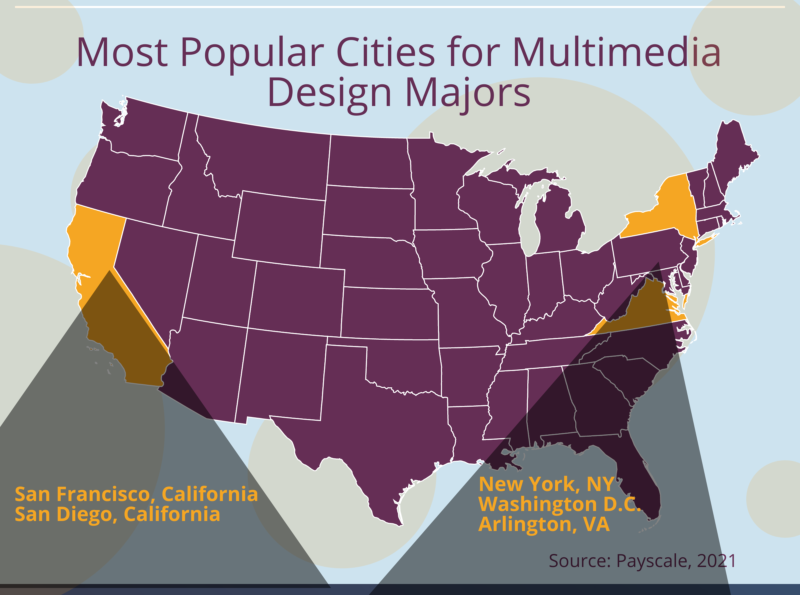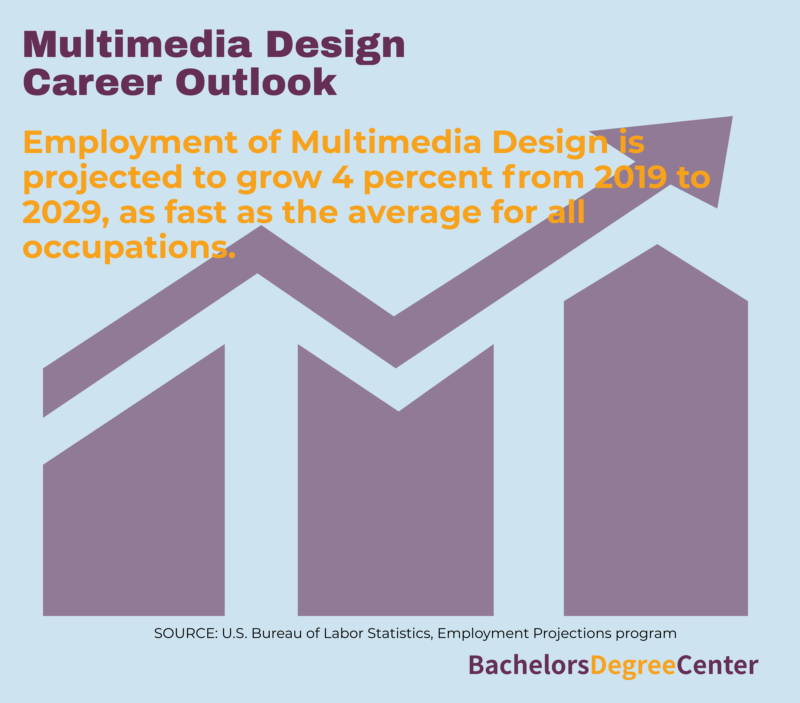Design has come a long way in a short time, with the rapid development of digital media breaking down all of the old technological barriers. Today, multimedia design uses a wide array of digital and analog tools to transform everyday life. With a degree or certificate in multimedia design, graduates can take ordinary websites and create exciting and new advertising campaigns that can be broadcast over television, radio, and the internet. With multimedia design, there are no limits on an artist’s creativity.
What Is Multimedia Design?
Multimedia design is an art form that uses many different types of media. This can include photography, video, graphic design, audio, written content, and many more. Multimedia design is used to create websites, video games, computer graphics, digital programming, mobile apps, as well as a wide variety of other forms of art and programming. Mdia design utilizes many forms of media to create one piece that may serve several different purposes. The ability to bring these many different kinds of media together to create useful designs takes an artist with a keen eye and the ability to use their imagination.
Multimedia design can be used in many different capacities. With the introduction of digital media, multimedia design has taken on even more depth and resilience. It can be used across more platforms than ever before. Multimedia design usually includes both audio and visual mediums. Computerized or digital graphics make it possible for the medium to be used in a variety of capacities, including television, video, radio, printed material, photography, and sound bytes, just to name a few.

School/ Program Accreditation
Accreditation is the process of verifying that a school or its degree programs exceed industry standards. Several protocols must be met verifying that when a student graduates they will have been taught the most accurate information and given the most up-to-date technologically advanced tools to date. They will be able to utilize the information and resources they have been given to become a profession in their chosen career field. Accredited status guarantees the value of the education the student receives. Accreditation also reinforces that the university and program are utilizing the most up to date information and technology possible.
Accreditation is an ongoing process. It must be renewed regularly, in some cases, every one or two years. If the accreditation process is not completed on a regular basis, accreditation will be lost and the entire process must start over. Requiring the school or program to renew their status every few years ensures that they are maintaining the highest possible standards supported by the industry. This is true just as true of multimedia design as it is of any other type of degree program.
Regional accreditation is used to verify the teaching methods and protocols of universities, colleges, and other institutions of higher learning. In order to become accredited, the school must be able to verify that its teaching methods are sound and can provide students with a learning environment that will allow them to thrive. The environment must be conducive to the students’ growth as well as their ability to explore options for their future. Both online and classroom learning should be easily accessible and taught by professional faculty members and instructors who are above reproach on every possible level. Regional accreditation also ensures that the course curriculums used for each degree program are as up to date as possible.
Specialized accreditation is the verification process used to ensure degree programs and certification/licensure programs offer the best educational materials possible for students who are trying to earn a multimedia design degree. Degree programs must be able to provide accurate information and resources that allow the student to learn the skills they need to successfully create multimedia designs. Just like regional accreditation, specialized accreditation must be renewed on a regular basis. In some cases, the review process must be performed every one or two years. With degree programs, however, reviews are also performed when curriculums are changed or additions are made to the certification process. When exams for certification and licensure are updated, the programs that are used to prepare for these tests must also be updated as well.
Types of Multimedia Design Bachelor’s Degrees
There are multiple types of Bachelor’s in Multimedia Design Degree programs. In addition to being taught online and in the classroom, students also have the choice of choosing an accelerated program. There are also numerous concentrations to choose from which will allow the graduate to follow along on a career path they enjoy. Multiple concentrations can be taken at one time that will allow the student to use their talents in many different ways and many different career paths.
Online Multimedia Design Programs
Online multimedia design degree programs offer the same learning opportunities as students who choose to attend class on campus. Online programs allow students to learn from any location and at their own convenience. Choosing an online program is an excellent way to continue their education while maintaining a full work schedule. Students are able to study at their own leisure allowing them to retain more information and go over lessons as needed. When enrolling in an online degree program, students are able to start their careers and begin applying what they learn as they move forward. Online multimedia design degree programs allow students to explore their options while attending college and looking at what career paths may be available to them. When enrolled in an online degree program, students can travel almost anywhere in the world and still attend their class as long as they have an internet connection.
Accelerated Multimedia Design Programs
Accelerated Bachelor’s in Multimedia degree programs condense the information contained in the curriculum’s lesson plans so that the student can graduate much earlier. A degree program that is traditionally 24 months or two years long, can be completed in 18 months or less. A degree program that is 36 months or three years long may be able to be completed in less than 30 months. Accelerated degrees can be taken online or in a classroom. Many people who choose to take an accelerated degree program are already working at a full-time job and want to complete their degree program in as little time as possible. Students who choose to enroll in an accelerated degree program often do so because they want to complete their studies as quickly as possible. Accelerated degrees are a great way to move forward with your education and enjoy new opportunities.
Digital Journalism
Digital journalism is a specialization of multimedia design that incorporates multiple forms of media in a platform that is used to relay information to large groups of people. Audio recordings, video, digital photography, graphic design, and many other digital forms of media are used to create documents or web-based publications. Digital journalism can be used to create publications that can be sent across the globe in just a few seconds compared to written or “hard” publications that could take months to reach their destinations. Digital journalism can also be used to condense large amounts of information into an easily transmittable format.
Game Production
Video games require many different types of media. Video, photography, audio, and graphic design are all used together to create the digital aspects of a video game. While computer coding lays the foundation of the video game itself, multimedia design is what makes it stand alone. The audio/visual elements and the interactive programming used to produce the game are all part of multimedia design. Earning a degree in multimedia design gives a student all of the tools and skills they will need to be able to design and develop every aspect of a video game.
Creative Industry Management
Creative industry management involves the ability to manage large groups of talent who work with all types of media, both digital and otherwise. This specialization includes multimedia design courses as well as management courses. The blended curriculum provides students with the coursework that inspires their creativity while at the same time providing them with the management skills they need to take care of the day to day operations of a successful company that specializes in multimedia design. A graduate with a Creative Industry Management degree can find work in the marketing industry, entertainment industry, and digital journalism.
Broadcast Journalism
Broadcast journalism is a specialization that includes video, audio, and digital elements that make it possible to broadcast news over several platforms. Programs can be transmitted via live stream, radio, television (analog), and digital. Journalism involves collecting information and creating valuable content. Broadcast journalism usually involves an audio broadcast over one of the prior mentioned platforms. When broadcast over the right platform, the signal can reach across the globe in a matter of seconds allowing for the publication to be sent to almost any location.
Website Development
Website development is a specialization that can include the use of many forms of media. Photography, audio, video, and graphic design are all used to create interactive websites that are used for many different purposes. Different websites use different combinations of media to make them more interesting as well as more informative. Websites and website management rely on the use of different forms of media to make them stand out and be as memorable as possible.
Event Reconstruction/Forensics
Forensics and event reconstruction requires the use of different forms of media to recreate an event or accident. Video and audio recording are essential, as well as being able to create three-dimensional images through the use of graphic design technology. Being able to use various types of media helps create an extremely accurate depiction of whatever even is being investigated. This type of forensics can be used by law enforcement and other organizations that study accidents and other catastrophic events.
Marketing Development and Strategies
Marketing and development and strategies can use many different types of media. In the marketing industry, all forms of media are used to develop marketing strategies that attract attention and build an audience for a specific brand. Audio and visual forms of media are used to inform and intrigue an audience. Creating interactive marketing tools involves using multiple forms of media over a specific platform.
Multimedia Design vs Graphic Design
Graphic design vs multimedia design is a common question many students ask. There is a major difference between the two types of design. Graphic design uses digital imagery and concepts to create two and three-dimensional designs. They are used to create prototypes and other projects in great detail. With graphic design, projects can be completed in layers so that every aspect of the design is complete.
Multimedia design involves the use of multiple forms of media that are brought together to create a final project. Multimedia design is often used to create websites, marketing tools, social media, and many other digital projects in a wide variety of industries. Using many forms of media in one project allows for maximum creativity and a design that would not be possible without the different elements being added.
Certifications for Multimedia Design
Certifications and licenses are available for many of the multimedia design professions. Certifications and licenses are intended to be able to provide verification that the graduate has surpassed all expectations of knowledge. Sitting for a state board certification or license exam and successfully passing it, proves that they have the proper understanding of the subject matter of their degree. Certifications and licenses can be used to advance a graduate’s career from designer to management. Having earned a certificate or license can also mean an increase in pay.
Certifications and licenses must be renewed regularly. Some licenses are good for one, two, or five years, depending on the industry and the type of license or certification. In between renewal times, the person must commit to a specific number of eligible continuing education credits. These credits can be electives that add up to the required number of credit hours or the person can enroll in a certification program that meets the objectives of the continuing education requirements. One of the benefits of enrolling in a certification program is the opportunity to learn about the latest technology and techniques in the industry.

Careers in Multimedia Design
There are many different careers that a graduate with a Bachelor’s degree in Multimedia Design degree. Multimedia and graphic design go hand in hand with many other types of management and design programs. Research and development students can also benefit from multimedia design. The following careers are just a few of the options available to graduates with a Bachelor’s in Multimedia Design.
Multimedia Artist and Animator – A multimedia artist and animator work with cartoons, animation, comic strips, caricatures, illustrator, marketing designer, and many other positions in which sketching, drawing, or illustrations are used on a regular basis. Multimedia artists and animators use a variety of mediums. Digital tablets and sketching apps for phones and other electronic devices make it possible for an artist to draw using almost any medium.
Graphic Designer – Graphic designers use digital programs to design and create two and three-dimensional renderings of almost any object. They are important members of design teams and can use computer programs to bring traditional drawings to life. Graphic designers can create computer software, video games, educational programs, and other computer or web-based programs.
Art Director – A graduate with a Bachelor’s in Multimedia Design offers individuals an opportunity to apply for Art Director positions as long as they have prior work experience in a similar field. As an art director, a graduate with a Bachelor’s in Multimedia Design can supervise the planning and creation of many different projects.
Marketing Specialist – A graduate with a Bachelor’s in Multimedia Design can find work as a marketing specialist. Marketing specialists use a variety of media types to create advertising campaigns social media posts, websites, banners, and digital billboards. Marketing specialists use multimedia design to create marketing strategies and campaigns for businesses and other professional organizations.
Digital Journalist – A Bachelor’s in Multimedia Design can be used to find employment as a digital journalist. Digital journalism involves using many different types of media to create informative journals on a wide variety of subjects. Digital journalism allows for publications to be produced in a digital format making it easily transferable over the internet.
Educator – With a Bachelor’s in Multimedia Design, a graduate can become an educator in almost any type of art or media-based class. Being able to teach others about the different types of media as well as how they are used when it comes to design. Becoming an educator can be a very rewarding career for those who are interested in helping students reach their full potential.
Salary
A graduate with a Bachelor’s in Multimedia Design can expect to earn anywhere from $50,000 to almost $100,000. A graphic designer can earn a median salary of $50,000 if they have the right degree plus a certification in design software. The earning potential will increase the more experience the candidate has. Graphic designers can work in many different industries. It is an excellent starting position for individuals who have recently graduated with their degrees.
The salary of a Multimedia Artist and Animator averages approximately $73,000 per year. While other degrees may require a certification or experience, an animator will be assessed on their portfolio of work as well as their Bachelor’s degree. Animator and Multimedia artists are mostly employed by the entertainment industry and marketing professionals who specialized in specific types of artwork.
Another option for a graduate with a Bachelor’s Multimedia Design is as an Art Director. Art Directors may apply with a Bachelor’s degree but will need a Master’s in order to advance upwards through the ranks. The annual salary on average for an Art Director is approximately $93,000. If an applicant has experience in a similar field, they may be able to earn more if they have the education to back it up. Art Directors are often in charge of expensive works of art and other valuable pieces. Individuals who work in this field, carry extra responsibility and are paid higher wages to compensate them for the additional work.

Professional Organizations in Multimedia Design
Multimedia Designers have the opportunity to join one of many professional organizations that can assist them in gaining a professional on their competitors. Choosing to join any one of these organizations will offer credibility to the candidate if they choose to apply for high-level positions.
AIGA – American Institute of Graphic Arts
The AIGA is the largest and the oldest of all the professional organizations for graduates with a degree in Multimedia Design. The organization represents over 20,000 professionals who specialize in design. Members include educators, students, and artists who work in the field.
CAA ‑Advancing Art & Design
Advancing Art & Design, formerly known as the College Art Association, is dedicated to promoting excellence in education by offering scholarships and other financial assistance to students who are interested in the visual arts. Creativity and the practice of art in all its forms are promoted.
Design History Society
The Design History Society is an international society that supports the study of design in all its forms.
Entertainment Software Association
The Entertainment Software Association serves companies that publish video games and computer games. The Society links to publications that cater to video game creators. The Society also keeps a list of colleges and universities that specialize in degrees that have to do with the software used in the entertainment industry.
IGDA – The International Game Developers Association
The International Game Developers Association is a non-profit organization that serves video game creators. It is the largest organization of its kind in the country.
National Art Education Association
The National Art Education Association is an exclusive organization for individuals who are employed as educators in the visual arts.
New Media Caucus
The New Media Caucus is a not for profit organization that operates on an international level. The organization promotes a full understanding of new media art and how it is developed.
National Council of Arts Administrators
The National Council of Arts Administrators is for arts administrators, past, present, and future, to allow them to come up with solutions to issues that many face in the field of fine arts and in higher education.
SEGD – Society for Environmental Graphic Design
The Society for Environmental Graphic Design is an organization that brings together what is considered the built environment and communication design. People who work on this platform strive to bring global unity by using the full potential of graphic design.
Related Rankings:
25 Best Bachelor’s in Multimedia Design
15 Best Online Bachelor’s in Multimedia Design
10 Fastest Online Bachelor’s in Multimedia Design

